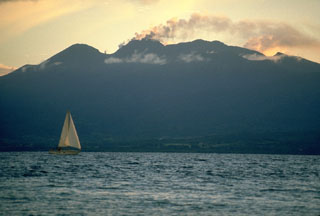Report on Soufriere Guadeloupe (France) — February 1977
Natural Science Event Bulletin, vol. 2, no. 2 (February 1977)
Managing Editor: David Squires.
Soufriere Guadeloupe (France) Phreatic activity continues; large explosion on 29 January
Please cite this report as:
Global Volcanism Program, 1977. Report on Soufriere Guadeloupe (France) (Squires, D., ed.). Natural Science Event Bulletin, 2:2. Smithsonian Institution. https://doi.org/10.5479/si.GVP.NSEB197702-360060
Soufriere Guadeloupe
France
16.044°N, 61.664°W; summit elev. 1467 m
All times are local (unless otherwise noted)
"Phreatic activity has continued at La Soufrière through 23 February. The largest explosion of the 1976-77 activity occurred at 1911 on 29 January 1977 and was heard by people living as far as 10 km from the summit. Lithic blocks as large as 0.5 m in diameter were thrown 1 km from the summit fissures. Five centimeters of ash was deposited at Savane à Mulets and 5 mm of ash fell on Matouba, 3 km W of the summit. Smaller phreatic explosions occurred on 13 and 15 February, and measurable amounts of ash were erupted on 5, 7, and 10-15 February. On 23 February only minor amounts of steam were being emitted from the volcano.
"In contrast to the eventful phreatic activity of recent weeks, the local seismicity has continued to decline. Only 6-10 earthquakes/day were detected 1-23 February and a felt event occurs only once in every 10 days.
"Petrographic study continues to confirm that ejecta from Soufrière consist only of older, altered material. No fresh glass has been observed. As before, ground deformation measurements with various types of tiltmeters (pendulum, borehole, dry tilt) have indicated no significant changes in the overall shape of the volcano."
Geological Summary. La Soufrière de la Guadeloupe volcano occupies the southern end of Basse-Terre, the western half of the island of Guadeloupe. Construction of the Grand Découverte volcano about 200,000 years ago was followed a Plinian eruption and caldera formation about 100,000 years later, and then by construction of the Carmichaël volcano within the caldera. Two episodes of edifice collapse and associated large debris avalanches formed the Carmichaël and Amic craters about 11,500 and 3,100 years ago, respectively. The present volcano subsequently grew within the Amic crater. The summit consists of a flat-topped lava dome, and several other domes occur on the southern flanks. Six phreatic explosive eruptions since 1690 opened radial fractures across the summit lava dome. The phreatic eruptions in 1976-77 caused severe economic disruption when Basse-Terre, the island's capital city immediately below the volcano, was evacuated.
Information Contacts: R. Fiske, SI.

